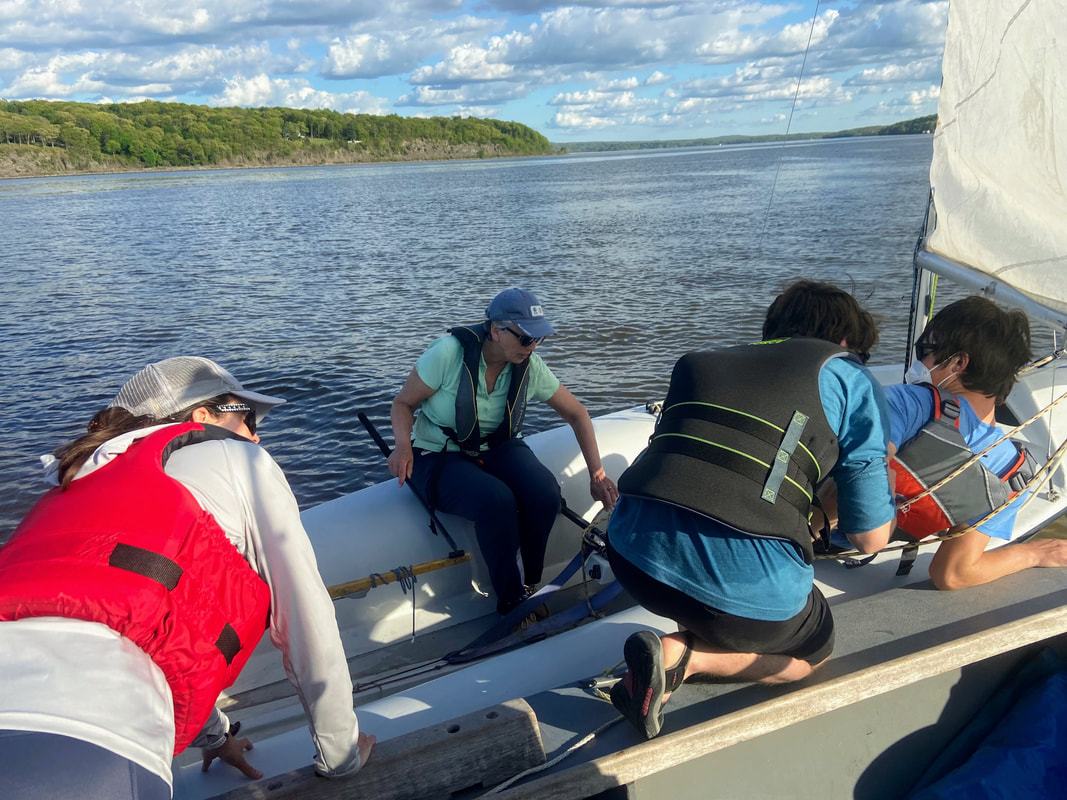|
Photo of 420 Centerboard Boat with HRMM Sailing School Sailing Instructors wearing various styles of life jackets during their Shakedown Sail, May 2022 Sailing is so much fun! But sometimes dangerous events can unfold out on the water, so if we're smart, we'll educate ourselves and learn the basics of safety to prevent most accidents, and we'll be prepared for any problems that do arise. Here are some safety tips to keep your sailing experiences fun.
Educate Yourself Learn as much as you can before going out boating or sailing. Boat US offers a free online boaters' safety course. You can learn the basics here for free: www.boatus.org/newyork. Take sailing classes through the Sailing School at the Hudson River Maritime Museum or through other schools.. A variety of classes are available for youth and adults. https://www.hrmm.org/sailing-school.html. Learn to Swim If a boat unexpectedly capsizes, the crew should always stay with the boat. Boats are designed to float, even if overturned, and the crew is always safer if they stay connected to the boat. However, sailors should be able to tread water comfortably and be able to comfortably swim 50 yards because in the event of an unexpected capsize, the crew needs to tread water and swim around the boat, tending to sails and righting the boat. Sailors need to be good basic swimmers to be comfortable with these tasks. Also, if a crew member falls overboard while their boat is sailing away from them, they will need to stay afloat as well! Their boat will turn around and come back to retrieve them, but the crew overboard must not panic, and they must keep their head above water while waiting to be retrieved. Having good, basic swimming skills is a really good idea. Wear a Lifejacket We can't predict when an unexpected puff of wind will hit us or a big wave will catch us off guard. Why not be prepared for the unexpected? If we wear a life jacket, we are much more likely to survive an unexpected capsize or crew overboard experience. People often ask, "What is the best life jacket?" My answer is any Coast Guard approved life jacket that is comfortable and that you will wear is best! Remember: a life jacket doesn't help much if it is not worn. Use a VHF Radio Sailors should carry and use a VHF Radio. They should monitor channel 16, the emergency channel. All mariners are required to help other boats in trouble, if they know how to safely do so. At the very least, they can call for help and stand by to render assistance as directed by more experienced mariners. Also, boaters can tune to channel 13 if they need to speak with the captain of a commercial vessel to communicate which way they intend to pass that vessel or some other important information. Finally, if boats are out with others, they can communicate on a pre-determined channel. Channel 16 is reserved for essential announcements and emergency information. Sail with Others It's so much fun to sail with other crew members on your boat and to sail with other boats. In this way, you are building a community, and you are available to help one another in case of equipment failure or breakdowns.
0 Comments
Your comment will be posted after it is approved.
Leave a Reply. |
AuthorStaff and volunteers of the Hudson River Maritime Museum's Wooden Boat School and Sailing & Rowing School. Archives
August 2023
Categories
All
|
|
GET IN TOUCH
Hudson River Maritime Museum
50 Rondout Landing Kingston, NY 12401 845-338-0071 [email protected] Contact Us |
GET INVOLVED |
stay connected |
Proudly powered by Weebly


 RSS Feed
RSS Feed